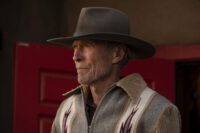Bless me, Father, for I have sinned. I have knowingly watched and enjoyed the entirety of Showa Era Godzilla movies, without a hint of irony. I present to you now a justification for this, a love letter to everyone’s favorite giant, radioactive reptile.
Over the years, there has been one unfortunate idea that has been shared by both Godzilla fans and critics alike—that the Showa Era of films are fun at times, but ultimately only enjoyable for their camp.
The ’50s: The Showa Era Begins
There is, perhaps naturally, the caveat made that the original stands on its own two legs, keeping balance with its tail as Godzilla moves around with a grave warning to share. A great atomic warning sign lights up the city as it shouts its message.
“Nuclear weapons are our undoing!” This message carves itself into the earth as it razes cities and cuts clean through power lines. No other man-made weapons can stop it: they serve only as mild deterrents.
For over an hour, a government tries to respond to a new danger that it can barely comprehend. In the end, a super-weapon is used by a creator who never wished to unleash it on the world, for fear of being forced to produce more to be used. He chooses to take his creation to the grave with him, using it but once after burning his notes.
It would be tawdry to assume that this is all Godzilla (1954, dir. Ishirō Honda) has to say, and all anyone has to say about Godzilla. This message is compounded, built upon, and brought back again and again throughout the decades of shooting at the messenger.
Godzilla Raids Again (1955, dir. Motoyoshi Oda) as he returns to remind humanity of the horror it has wrought. This time, he is not alone, Anguirus is here, another horror juxtaposed with a very gentle love between members of the human cast. The very things that repel Godzilla attract Anguirus—these are weapons that only breed more war, it seems.
If these descriptions seem overly dramatic for a series about people in lizard costumes fighting each other, it’s because they are. However, Godzilla as a franchise has always carried itself with a knowledge of its symbolism and an understanding that it encapsulates a very real fear.
Even when at its goofiest and most childlike, even as Minilla comes into the picture and trips over his own feet, Godzilla in the Showa Era always presented itself with an earnest message. Certainly, fears of destruction, death, and displacement are present, but there’s always something more, that particular kind of existential fear that you can’t quite adequately explain to a child as you tuck them extra tightly into bed after watching All Monsters Attack.
There’s an undeniable charm to this era of Godzilla. With films ranging from self-serious to campy, or just downright goofy, it’s all presented with an earnestness of some kind—the desire to tell a story, not just build a franchise. It’s been refreshing to go back and revisit films that don’t roll their eyes at their own stories, that don’t try to quip away unbelievable events, and that aren’t afraid to be movies.
It cannot be overstated how relaxing it is to put on a movie that’s under 90 minutes long after work and watch it be as weird as it wants, without needing to worry about the marketability of itself as part of a larger brand.
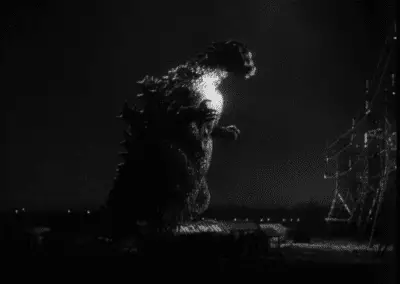
A lot of care and fun clearly went into the making of these films. People painstakingly creating miniature versions of cities and buildings for the sole purpose of being destroyed by someone in costume are maybe one of the best examples of this. All of that hard work, time, and care that needed to be put into this work so you can celebrate its destruction on screen—that feeling surely must be like no other.
As the Showa Era matured, so too did Godzilla. The monster raging in its infancy gave way to a protector of mankind, a friend to the very people he once threatened. As visions of the uses of nuclear energy changed from atomic bombs to power plants, Godzilla changed with it.
The ’60s: The Expanding Universe
By the time Mothra vs. Godzilla (1964, Ishirō Honda) rampaged into theaters in the decade after Raids Again, corporate greed had grown into the threat audiences would see on the silver screen. Not unlike our own world, someone had to inevitably capitalize on this natural phenomenon, even if it meant great risk to others.
Beyond the shift to color, and the crossover between Toho’s own monsters, Mothra vs. Godzilla shows one of the first major shifts in tone for the era. Whereas there had been some strife between humanity before this, for the first time it feels real. Even with kaiju outside your window, people find something to argue over, to harm each other over.
Mothra also deserves a special mention for introducing style icon Junko Nakanishi, a news photographer who manages to be one of the most developed female characters in the entire Showa Era of Godzilla—all while seeming to know more than her boss.
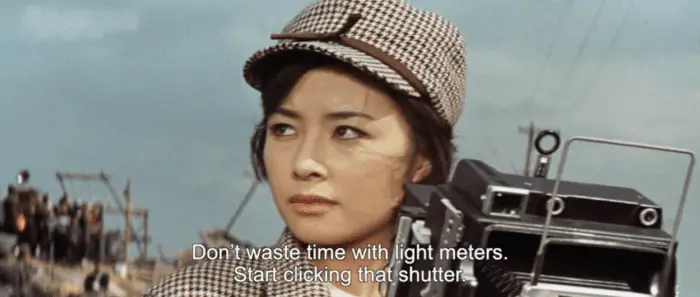
With real human costs on the table, Ghidorah, The 3-Headed Monster (1964, dir. Ishirō Honda) brought international intrigue with it as it descended upon the earth.
There’s a particular terror in Ghidorah, as it shows three superpowers fighting another, more aggressive, invader. Even as they’re just barely able to stop Ghidorah, the entire film shows the adult fear of an international incident. Assassination attempts, and losing one’s identity, they’re all present here as a new threat arrives. As a war between monsters escalates, any possible one between men must be prevented.
Even as all this goes on, the film opens with a very direct reference to climate change—not the last in this era of Godzilla by any means. With all of this happening, Ghidorah manages to keep its tone lighthearted and immensely charming, fully embracing this weird world in which it finds itself. One of Mothra’s larvae tries to reason with Godzilla and Rhodan and is pulled up a hill by the former, a princess appears to have her mind somehow taken over by a prophet from Venus, and Ghidorah finally leaves the planet after Godzilla starts throwing rocks at it.
I love this series.
Invasion of Astro-Monster (1965, Ishirō Honda) is like Ghidorah, but instead of all that, it’s about colonialism. There’s quite a bit to love here, but I don’t think any can top the introduction of the Housewives Delegate. There are few characters in all of film who, by their mere introduction, raise more questions than they could ever possibly answer.
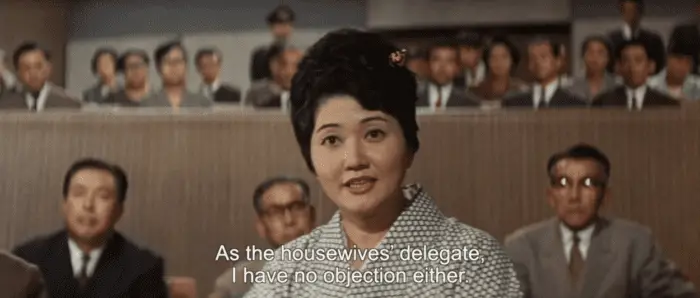
This film also features Glenn. Glenn has no complete name, being the bizarre international astronaut of mystery that he is. Somehow, Glenn managed to fall in love with an alien secret agent, who was identical to all of the other women of her race, the Xilians—the same race that requested custody of Godzilla and Rhodan to help them ward off a threat approaching their planet. He would even have the first on-screen kiss in the franchise. His appearance added nothing and, somehow, everything.
The Xilians later reveal themselves to be able to control the kaiju, to an extent, and use Godzilla and Rhodan to fight off Ghidorah once again. While Mothra doesn’t join in on the fun, Godzilla returns to his tactic of throwing rocks, which has a 100% success rate.
This one in particular is remarkably strange. It feels like another sci-fi film from the era with kaiju inserted after the script was finished, even though the plot is so dependent on them. Astro-Monster shows an invading force effectively attempting to colonize the earth, presenting a cure for cancer which ended up only being a declaration of war, should humanity not agree to exist under the Xilians. Being shot in ways somewhere between the rest of the series and a Kubrick flick, it leaves such a bizarre impression that it’s difficult to do anything but stare in admiration.
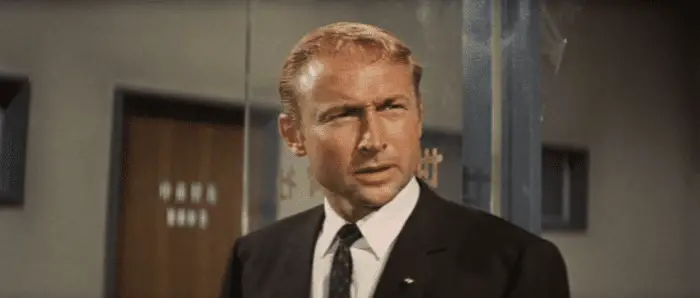
Ebriah, Horror of the Deep (1966, dir. Jun Fukuda) is equally strange. Again, it feels as if it carries anti-colonialist sentiment with it, as an island’s native population fights back and stages a rebellion against its colonizers. There is, also, a giant crab. Between this film and Astro-Monster, we see Godzilla gain much more personality and even have an outright declaration that he’s misunderstood. This comes just in time for…
Son of Godzilla. Wow.
It pains me to write this, but Son (1967, dir. Jun Fukuda) isn’t a horrible movie—I’ve certainly seen worse. Hell, I’ve paid to see worse in theaters multiple times. It has so much charm as this weird little comedy in the middle of everything, with Godzilla’s son Minilla slowly growing on me as he interacts with his dad more and more.
Make no mistake, Minilla is hideous, and were I Godzilla, I would have likely left for cigarettes never to return, but their relationship is cute. There’s something about a son trying so hard to impress his father while falling flat on his face that you can’t help but smile at.
This film also gives some incredibly direct screentime to climate change, with a manmade weather device which both created new monsters and, in one of the saddest scenes in the franchise, puts Godzilla and Minilla into hibernation, embracing each other as the island freezes around them.
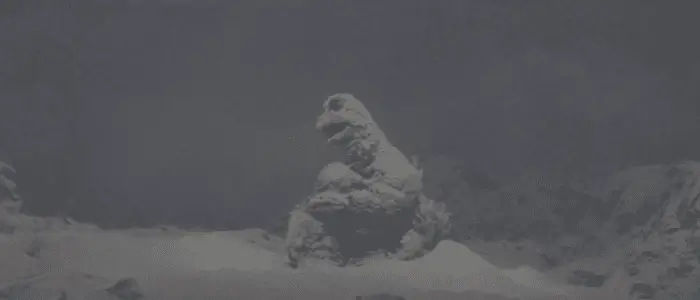
Destroy All Monsters (1968, dir. Ishirō Honda) is a bit of a mess. It’s a fun mess, and no worse than any others, but a mess nonetheless. All of the kaiju are placed on Monster Island, which sounds more like a Scooby-Doo episode than a Godzilla movie. Once again, an alien force attacks the planet, attempting to use all of the monsters against humanity.
After so long without it, seeing Godzilla rampage through a city is refreshing. There’s a surprising lack of city destruction in these films, especially given their reputation.
This film does something special. Unless I missed it, it appears to have been the first time that the kaiju made each other bleed. During the fight, a wound on Ghidorah’s neck actually appears to flow red.
It’s oddly humanizing, a reminder that these monsters too feel pain and sustain injuries. With the blood onscreen from both human and kaiju, this feels so odd as a follow-up to Son of Godzilla, as if someone at Toho made the decision to declare that “the kids have had their fun, now it’s our turn again.”
All Monsters Attack (1969, dir. Ishirō Honda) does not feature all of the monsters, perhaps fortunately. It also doesn’t really feature any, as all of the scenes with them take place in a child’s imagination. This all sounds like it should deter people, but it manages to be a strangely strong entry even with this information—it’s enamoring in how it tells its story.
Ichiro, a child with two overworked largely—absentee parents, spends his time daydreaming about Godzilla and Minilla, an escape from both his quiet home and from the reality that he’s been bullied relentlessly. Just as Minilla learns to stand up for himself in these dreams, so does Ichiro.
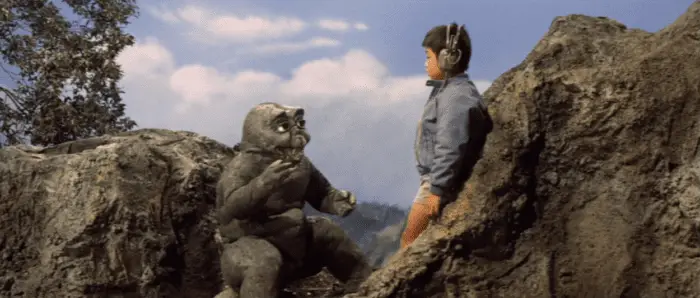
More terrifying for parents is that Ichiro is kidnapped as part of a larger crime that continues to escalate. He manages to escape and find help, taking his kidnappers directly to the authorities with him. Just like the rest of the films here, even while aiming this particular entry at children, it manages to capture very real adult fears.
Minilla also talks in this one. Sure, it didn’t actually happen, but it’s a novel to behold, especially with his newfound ability to shrink to the size of a human.
The ’70s: Monsters of Our Own Creation
Godzilla vs. Hedorah (1971, dir. Yoshimitsu Banno) could not more clearly be about pollution. As the films began adding original opening songs shortly before this, Hedorah is no different, with the song outright stating the theme. Hedorah is a trash monster who turns people into skeletons, and Godzilla flies by holding his tail and using his radioactive breath like a jet engine. It’s a perfect movie, no notes.
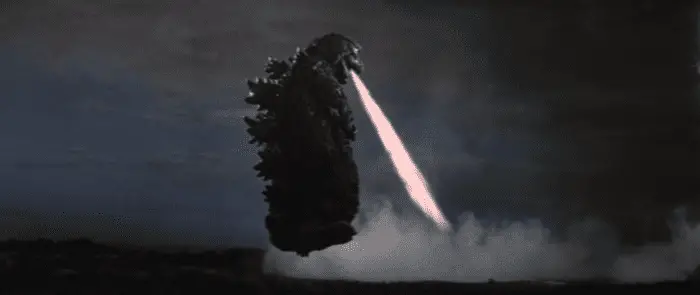
If Hedorah wasn’t clear enough about humanity’s waste making the earth uninhabitable, Godzilla vs. Gigan (1972, dir. Jun Fukuda) escalates things with an alien race of sentient cockroaches running a theme park. With the goal of taking over the earth for them to inhabit, the aliens summon Ghidorah and the cyborg Gigan. This one has some of the most city destruction and feels more like a vehicle to show the fight than some of the others. It also, however, features a remarkably self-aware camp that comes across as endearing, rather than annoying.
Godzilla vs. Megalon (1973, dir. Jun Fukuda) may have introduced the titular Megalon, but it is quickly overshadowed by Jet Jaguar’s introduction. With nuclear weapon tests bringing a monster to shore, it feels like a return to form in many ways, even mimicking Godzilla’s development into a character with Jet Jaguar developing a will of its own. It also features Godzilla flying horizontally to dropkick Megalon twice consecutively, one of the most beautiful things ever put on film.
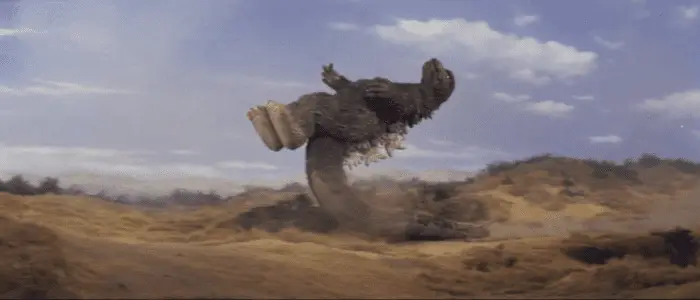
Godzilla vs. Mechagodzilla (1974, dir. Jun Fukuda) and Terror of Mechagodzilla (1975, dir. Ishirō Honda) really go hand in hand, ending this era with a direct sequel, not unlike how it began. There’s something uncanny about it, with the drama again revolving around a small human cast battling with aliens—things are different this time, however. There’s an air of intrigue around the former’s plot, almost more akin to a sci-fi noir at times.
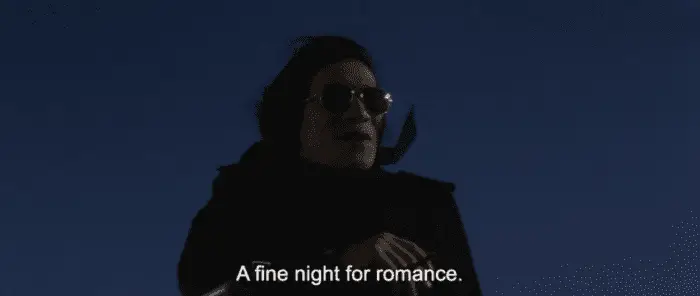
With a prophecy about summoning King Caesar, who ultimately defeats the mechanical monstrosity, there’s a compounding sentiment of modernity losing to tradition throughout the entire film. Godzilla also powers up by screaming in the rain until being hit by lightning, which is incredible.
In Terror, it’s clear to see why it ended this era of Godzilla films. While it certainly was nice to have a direct sequel after so many years of films that seemed to stand alone, in many ways it felt like a rehash of the film released the previous year. With an old enemy now blending in to bring back their ideas and weapons after losing, at times it feels like a form of commentary on domestic terrorism, although I’m not well-versed enough in Japanese history to ever directly state that as fact.
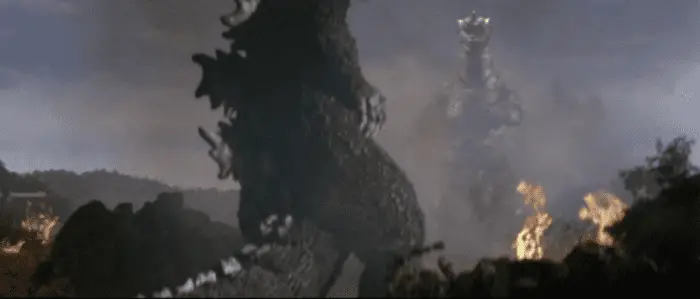
Maybe it’s the consequences of watching nothing but Godzilla for a week straight, but something about Terror just really didn’t land. It’s a film living in this universe but doing nothing to shape it. At the very least, it provides a fitting end to this story with Godzilla fighting alone for the first time in several films.
The End of the Showa Era
All of this is to say, that at its best and at its worst, I love Show Era Godzilla. Even when the films are just an excuse to watch guys dressed as monsters hit each other, it’s always trying to say something. That’s commendable, if nothing else.
For a series that’s perhaps best known for its monsters, there’s something so beautiful about the fact that, as they endure, so too does the message of Godzilla. Human cruelty and action without morals will be our undoing—but it doesn’t have to be.
I love Godzilla.



